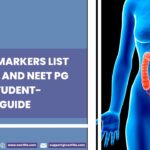Toxicology is that branch of the medical sciences dealing with the examination of chemicals and their effect on living things. Medical personnel, especially FMGE aspirants (Foreign Medical Graduate Examination) and NEET PG (National Eligibility cum Entrance Test for Postgraduate), require knowledge about antidotes and poisons. Statistics regarding the most frequent poisons, their appearance and symptomatology, and antidotes are useful to clinical practice and education to be available while carrying out successful and timely treatment of cases of poisoning. Mechanism of Action of Poisons and Their Types
A poison can cause an intoxication by acting on any of the enormous array of materials that range from chemicals and drugs to biologic toxins. Whether the syndrome caused by the poison’s clinical action is reversible or irreversible will be decided by the mode of action of the poison, as will the syndrome itself.
- Cytotoxic poisons destroy cells and harm cells by stopping cell metabolism. Organophosphates and cyanide are instances.
- These act on the nervous system by breaking conduction in the nerves or poisoning the nerve cells to death. Lead, mercury, and certain insecticides are some examples.
- They poison liver cells. The best-referenced example would be acetaminophen overdose.
- They are toxic to the kidney and renal process. Antifreeze or ethylene glycol and certain heavy metals like cadmium are some to name.
- These are toxically acting on the heart either through its function or rhythm to pump the blood. Some to name include antidepressants and digoxin.
Common Poisons and Antidotes
The respective poison’s antidote should be well known in order that cases of poisoning might be handled easily. Most commonly used poisons with their antidotes, put to practice in the field by FMGE and NEET PG Exam, include
- metabolized in the liver to toxic metabolites and, in overdose, to hepatic necrosis.
- Antidote: N-acetylcysteine (NAC)—It increases the level of glutathione, which helps in detoxification of the liver.
- Exam Key Point: NAC works best within 8 hours of ingestion.
- Mechanism – Organophosphates decrease acetylcholinesterase enzymatic activity and are anticholinesterases and thus cause acetylcholine buildup and overstimulation of cholinergic receptors, presenting as salivation, lacrimation, urination, defecation, gastrointestinal distress, and emesis (SLUDGE).
- Antidote—Atropine—Administered to reverse muscarinic effect. Pralidoxime (PAM) also reactivates acetylcholinesterase if administered in a timely manner.
- Location of Instructional Focus – Atropine to reverse muscarinic, and pralidoxime to reverse muscarinic and nicotinic.
- Pathophysiology – Cyanide is fixed by cytochrome c oxidase in mitochondria and prevents tissue hypoxia and cellular respiration.
- Hydroxocobalamin and sodium thiosulfate. Sodium thiosulfate contributes sulfur groups in order to combat the toxic effect of cyanide by oxidizing the toxic cyanide to the less toxic form thiocyanate to be excreted from the body by urine. Cyanide is bound by hydroxocobalamin, and cyanocobalamin is excreted from the body by urine.
- Exam Key Point to Remember – Headache, dizziness, confusion, and seizures are typical of cyanide poisoning.
- Mechanism: Inhibition of the Na+/K+ ATPase pump by digoxin, increase in intracellular calcium with resulting arrhythmias.
- Antidote: digoxin-specific antibody (sheep-derived Digibind).
- Exam Key Point – Digitalis toxicity is classically most commonly presented with visual alterations (e.g., yellow vision), nausea, and arrhythmias.
- Mechanism: Oxidative damage to cellular membranes induced by iron, secondary gut damage, shock, and hepatotoxicity.
- Antidote: Deferoxamine—Binds free iron to be excreted by the kidneys.
- Exam Key Point – Acute iron poisoning requires deferoxamine, causing reddish-brown urine coloration.
- Pathophysiology – Metabolized to formaldehyde, then formic acid, the latter retinotoxic and causing blindness and metabolic acidosis.
- Antidote – Fomepizole or Ethanol—Both inhibitors of alcohol dehydrogenase that prevent methanol metabolism to toxic metabolites.
- Important Point of Inspection – Blindness, vomiting, nausea, dizziness, and headache are due to methanol poisoning.
- Mechanism – Benzodiazepines cause CNS depression by increasing neurotransmitter GABA action on the receptor GABA-A.
- Antidote—Flumazenil: It is a GABA receptor antagonist that will reverse benzodiazepine action.
- Critical Point of Exam – Use caution while administering flumazenil in seizure patients or tricyclic antidepressants.
- Mechanism—Carbon monoxide is attached much more strongly than oxygen to hemoglobin to carboxyhemoglobin and disrupts tissue oxygenation.
- Antidote: 100% Oxygen—By non-rebreather mask that displaces carbon monoxide from hemoglobin and enhances carboxyhemoglobin clearance.
- Rare Exam Point Reduction – To be started at the earliest in cases of suspicion, and hyperbaric oxygen therapy may be considered in complex cases.
- Mechanism – Metabolized to glycolic acid and oxalic acid and causes renal failure and metabolic acidosis.
- Antidote: Fomepizole or ethanol—both alcohol dehydrogenase inhibitors—thus prevent metabolism of ethylene glycol to its toxic metabolites.
- Point of Examination of Importance – Ethylene glycol toxicity is most often described as CNS depression, hypocalcemia, and renal failure.
- Pathophysiology: An anticoagulant, heparin, binds to and inhibits thrombin and factor Xa activity. Bleeding heparin.
- Antidote: Protamine Sulfate—Binds to and antagonizes heparin’s anticoagulant effect.
- Point of Examination of Importance – Protamine sulfate must be administered with caution, as it will result in hypotension with rapid intravenous injection.
The students should be familiar with the poisons, their presentation, and the antidotes of the NEET PG and FMGE exams. The best way to do that is to use common poisons, their pathophysiology and presentation, and, most importantly, the antidotes and management. Antidotes are just the starting point in treating poisonings—true clinical wisdom also means providing supportive care, closely monitoring the patient, and ensuring proper follow-up to guide them safely through recovery.
These are a collection of significant toxins and antidotes most typically trimmed by clinical trials. The medication and the antidotes make you sure while offering toxicology questions and also most likely to pass exams on that.
Crack the FMGE Exam with Confidence—Download the Nextillo App Now on iOS & Android!”





